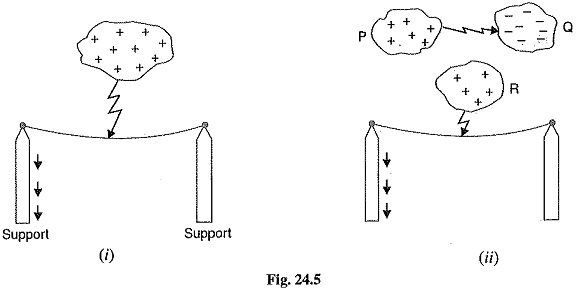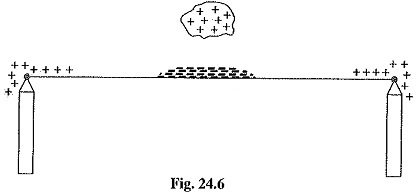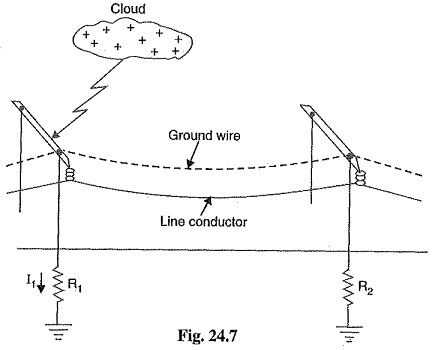Types of Lightning Strikes:
There are two Types of Lightning Strikes may strike the power system (e.g. overhead lines, towers, sub-stations etc.), namely;
-
Direct stroke
-
Indirect stroke
1. Direct stroke:
In the direct stroke, the lightning discharge (i.e. current path) is directly from the cloud to the subject equipment e.g. an overhead line. From the line, the current path may be over the insulators down the pole to the ground. The overvoltages set up due to the stroke. may be large enough to flashover this path directly to the ground. The direct strokes can be of two types viz. (i) Stroke A and (ii) stroke B.
(i) In stroke A, the lightning discharge is from the cloud to the subject equipment i.e. an overhead line in this case as shown in Fig. 24.5 (1). The cloud will induce a charge of opposite sign on the tall object (e.g. an overhead line in this case). When the potential between the cloud and line exceeds the breakdown value of air, the lightning discharge occurs between the cloud and the line.
(ii) In stroke B, the lightning discharge occurs on the overhead line as a result of stroke A between the clouds as shown in Fig. 24.5 (ii). There are three clouds P, Q and R having positive, negative and positive charges respectively. The charge on the cloud Q is bound by the cloud R. If the cloud P shifts too near the cloud Q, then lightning discharge will Occur between them and charges on both these clouds disappear quickly. The result is that charge on cloud R suddenly becomes free and it then discharges rapidly to earth, ignoring tall objects.
Two points are worth noting about direct strokes. Firstly, direct strokes on the power system are very rare. Secondly, stroke A will always occur on tall objects and hence protection can be provided against it. However, stroke B completely ignores the height of the object and can even strike the ground. Therefore, it is not possible to provide protection against stroke B.
2. Indirect stroke:
Indirect strokes result from the electrostatically induced charges on the conductors due to the presence of charged clouds. This is illustrated in Fig. 24.6. A positively charged cloud is above the line and induces a negative charge on the line by electrostatic induction. This negative charge, however, will be only on that portion of the line right under the cloud and the portions of the line away from it will be positively charged as shown in Fig. 24.6. The induced positive charge leaks slowly to earth via the insulators. When the cloud discharges to earth or to another cloud, the negative charge on the wire is isolated as it cannot flow quickly to earth over the insulators. The result is that negative charge rushes along the line is both directions in the form of travelling waves. It may be worthwhile to mention here that majority of the surges in a transmission line are caused by indirect Types of Lightning Strikes strokes.
Harmful Effects of Types of Lightning Strikes:
A direct or indirect lightning stroke on a transmission line produces a steep-fronted voltage wave on the line. The voltage of this wave may rise from zero to peak value (perhaps 2000 kV) in about 1 μs and decay to half the peak value in about 5μs. Such a steep-fronted voltage wave will initiate travelling waves along the line in both directions with the velocity dependent upon the L and C parameters of the line.
(i) The travelling waves produced due to lightning surges will shatter the insulators and may even wreck poles.
(ii) If the travelling waves produced due to Types of Lightning Strikes hit the windings of a transformer or generator, it may cause considerable damage. The inductance of the wiiidings opposes any sudden passage of electric charge through it. Therefore, the electric charges “piles up” against the transformer (or generator). This induces such an excessive pressure between the windings that insulation may breakdown, resulting in the production of arc. While the normal voltage between the toms is never enough to start an arc, once the insulation has broken down and an arc has been started by a momentary overvoltage, the line voltage is usually sufficient to maintain the arc long enough to severely damage the machine.
(iii) If the arc is initiated in any part of the power system by the lightning stroke, this arc will set up very disturbing oscillations in the line. This may damage other equipment connected to the line.
Protection Against Lightning:
Transients or surges on the power system may originate from switching and from other causes but the most important and dangerous surges are those caused by lightning. The lightning surges may cause serious damage to the expensive equipment in the power system (e.g. generators, transformers etc.) either by direct strokes on the equipment or by strokes on the transmission lines that reach the equipment as travelling waves. It is necessary to provide protection against both kinds of surges. The most commonly used devices for protection against lightning surges are :
- Earthing screen
- Overhead ground wires
- Lightning arresters or surge diverters
Earthing screen provides protection to power stations and sub-stations against direct strokes whereas overhead ground wires protect the transmission lines against direct lightning strokes. Flow-ever; lightning arresters or surge diverters protect the station apparatus against both direct strokes and the strokes that come into the apparatus as travelling waves. We shall briefly discuss these methods of protection.
The Earthing Screen:
The power stations and sub-stations generally house expensive equipment. These stations can be protected against direct lightning strokes by providing earthing screen. It consists of a network of copper conductors (generally called shield or screen) mounted all over the electrical equipment in the sub-station or power station. The shield is properly connected to earth on at least two points through a low impedance. On the occurrence of direct stroke on the station, screen provides a low resistance path by which lightning surges are conducted to ground. In this way, station equipment is protected against damage. The limitation of this method is that it does not provide protection against the travelling waves which may reach the equipment in the station.
Overhead Ground Wires:
The most effective method of providing protection to transmission lines against direct lightning strokes is by the use of overhead ground wires as shown in Fig. 24.7. For simplicity, one ground wire and one line conductor are shown. The ground wires are placed above the line conductors at such positions that practically all lightning strokes are intercepted by them e. ground wires). The ground wires are grounded at each tower or pole through as low resistance as possible. Due to their.proper location, the ground wires will take up all the lightning strokes instead of allowing them to line conductors.
When the direct lightning stroke occurs on the transmission line, it will be taken up by the ground wires. The heavy lightning current (10 kA to 50 kA) from the ground wire flows to the ground, thus protecting the line from the harmful effects of Types of Lightning Strikes. It may be mentioned here that the degree of protection provided by the ground wires depends upon the footing resistance of the tower. Suppose, for example, tower-footing resistance is R1 ohms and that the lightning current from tower to ground is I1 amperes. Then the tower rises to a potential Vt given by ;
Since Vt (= I1R1) is the approximate voltage between tower and line conductor, this is also the voltage that will appear across the string of insulators. If the value of Vt is less than that required to cause insulator flashover, no trouble results. On the other hand, if Vt is excessive, the insulator flashover may occur. Since the value of Vt depends upon tower-footing resistance R1, the value of this resistance must be kept as low as possible to avoid insulator flashover.
Advantages
- It provides considerable protection against direct lightning strokes on transmission lines.
- A grounding wire provides damping effect on any disturbance travelling along the line as it acts as a short-circuited secondary.
- It provides a certain amount of electrostatic shielding against external fields. Thus it reduces the voltages induced in the line conductors due to the discharge of a neighbouring cloud.
Disadvantages
- It requires additional cost.
- There is a possibility of its breaking and falling across the line conductors, thereby causing a short-circuit fault. This objection has been greatly eliminated by using galvanised stranded steel conductors as ground wires. This provides sufficient strength to the ground wires.


